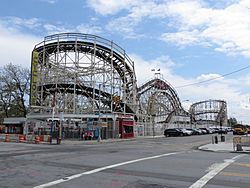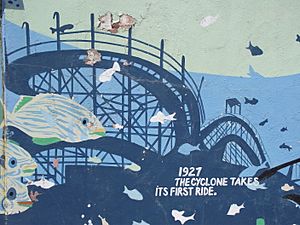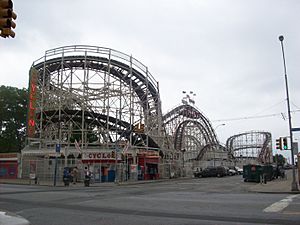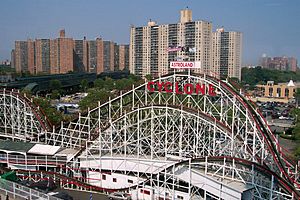Coney Island Cyclone facts for kids
Quick facts for kids Coney Island Cyclone |
|
|---|---|

Seen from Surf Avenue in 2013
|
|
| Coney Island | |
| Location | Coney Island |
| Coordinates | 40°34′27″N 73°58′40″W / 40.57417°N 73.97778°W |
| Status | Operating |
| Opening date | June 26, 1927 |
| Cost | $175,000 |
| Replaced | Giant Racer |
| Designated: | June 25, 1991 |
| Reference #: | 91000907 |
| Designated: | June 12, 1988 |
| Reference #: | 1636 |
| General statistics | |
| Designer | Vernon Keenan |
| Track layout | Compact Twister |
| Lift/launch system | Chain-lift |
| Height | 85 ft (26 m) |
| Length | 2,640 ft (800 m) |
| Speed | 60 mph (97 km/h) |
| Inversions | 0 |
| Duration | 2:30 |
| Max vertical angle | 58.1° |
| Capacity | 1440 riders per hour |
| G-force | 3.75 |
| Height restriction | 54 in (137 cm) |
| Coney Island Cyclone at RCDB | |
The Coney Island Cyclone, also known as the Cyclone, is a famous wooden roller coaster. You can find it at Luna Park in Coney Island, Brooklyn, New York City.
A designer named Vernon Keenan created the ride. It first opened to the public on June 26, 1927. The Cyclone is located where Surf Avenue and West 10th Street meet. This exciting coaster can reach a top speed of 60 miles per hour (97 km/h). Its track is 2,640 feet (800 m) long, and it has a highest point of 85 feet (26 m).
The Cyclone ran for over 40 years. But by the early 1970s, it started to wear out. The city even thought about tearing it down. However, on June 18, 1975, Dewey and Jerome Albert, who owned the nearby Astroland park, agreed to run the ride.
The roller coaster was fixed up in late 1974 and opened again on July 3, 1975. Astroland Park kept spending money to keep the Cyclone in great shape. After Astroland closed in 2008, Carol Hill Albert continued to operate the Cyclone. Then, in 2011, Luna Park took over running the famous coaster.
The Cyclone was named a special New York City landmark on July 12, 1988. It was also added to the National Register of Historic Places on June 26, 1991. This means it's an important historical site.
Contents
History of the Cyclone
How the Cyclone Started

Coney Island was once the biggest amusement area in the United States. This was from around 1880 until World War II. Millions of people visited it every year. The spot where the Cyclone now stands used to have another ride called the Giant Racer from 1911 to 1926.
Two brothers, Irving and Jack Rosenthal, saw how popular other coasters were. They bought land at Surf Avenue and West 10th Street to build their own ride. They invested a lot of money and hired Vernon Keenan to design it.
The construction was overseen by Harry C. Baker. Different companies helped build it, supplying steel and wood. The Cyclone cost about $175,000 to build. When it opened on June 26, 1927, a ride cost 25 cents. Today, a ticket costs $10.
In 1935, the Rosenthals started managing Palisades Park in New Jersey. Christopher Feucht then took over the Cyclone. He was a Coney Island business owner who had built another ride. The Cyclone's first drop was made a bit smaller in 1939. Even so, it stayed very popular.
When Things Got Tough
By the 1960s, fewer people were visiting Coney Island. More crime, not enough parking, and bad weather were some reasons for this. The last big theme park there, Steeplechase Park, closed in 1964.
The city bought the Cyclone in 1965. A new building for the New York Aquarium was built next to the Cyclone in 1954. In 1967, New York City decided to expand the aquarium onto the Cyclone's land. The city bought the Cyclone for $1.2 million in 1969.
The Cyclone was then run by a company called East Coaster Corporation. But the city didn't do much to keep the ride in good shape. Soon, the coaster had many safety problems. In 1972, when plans to tear down the Cyclone were announced, a "Save the Cyclone" campaign began. People wanted to protect Coney Island's last wooden roller coaster.
The owners of the AstroWorld theme park in Houston thought about moving the Cyclone there. But it was too expensive. Instead, they built a copy of it, which they called the Texas Cyclone.
By 1974, city officials changed their minds about tearing down the Cyclone. They decided to let a private company run it. Tearing down the Cyclone would have been bad for Coney Island's economy. In April 1975, the city asked companies to bid on leasing the ride. The owners of the Astroland amusement park won the lease. They paid $57,000 each year. After Astroland spent money to fix up the Cyclone, it reopened on July 3, 1975.
Keeping the Cyclone Alive
In 1986, the Cyclone had to stay closed until July because of insurance issues. After Astroland closed in 2008, the Cyclone kept running on its own. In 2011, the nearby Luna Park took over managing the Cyclone. They did a big renovation of the coaster. This work was finished in 2016.
The Cyclone Today
The ride covers a large area on Surf Avenue and West 10th Street. This land is owned by NYC Parks. There used to be concession stands built into the coaster's structure. Now, a souvenir stand selling Cyclone items and on-ride photos is there.
At Luna Park, each ride costs a certain number of credits. One credit usually costs $1. As of 2019, a ride on the Cyclone costs 10 credits, which is $10. The Cyclone is considered a very special ride. This is because new wooden coasters like it cannot be built under today's New York City building rules.
Riding the Cyclone
How the Ride Works
The train leaves the station and turns right. It then goes up an 85-foot (26 m) lift hill. After that, it drops down a steep 58.1-degree hill. As the train reaches the bottom, it feels like your head might hit the track above!
Next, the train goes up into a fast U-turn to the left. It then drops again under the lift hill. It rises into a second 70-foot-tall (21 m) U-turn to the right. The train goes down next to the lift hill and enters a camelback hill. This is a small hill that gives you a feeling of weightlessness.
It then goes up to a smaller U-turn to the right. After this, it dives under the first fast curve. After the third U-turn, the train enters another camelback hill. It has a fan turn and a smaller airtime section. Then it goes into a fourth U-turn to the right. The train bounces several more times before a final right curve. It drops a little, goes into a tunnel, and then hits the brake run before returning to the station.
The Track and Look
The track is 2,640 feet (800 m) long. It has six fan turns and twelve drops. The ride's top speed is 60 miles per hour (97 km/h). Each ride takes about one minute and fifty seconds. The track is brown wood with red fences. Its white support structure makes it look unique. The word "Cyclone" is spelled out in big, red, glowing letters on the sides of the lift hill. A fence surrounds the coaster.
Before the year 2000, the Cyclone's first drop was the third steepest wooden coaster drop in the world. As of 2014, it has the ninth steepest drop among wooden coasters worldwide.
The Trains
The Cyclone has three trains, each with three cars. Only one train can run at a time. Riders sit two across in four rows. This means 24 riders can be on one train. The trains have bench seats, not individual ones. A single lap-bar restraint system holds everyone in the row. The seats do not have headrests.
The Station
You get to the station from the ticket booth on West 10th Street. It has two wooden platforms. The platform on the outside is for people getting on the ride. The platform on the inside is for people getting off. The station has a roof supported by a steel frame. A tall sign with glowing letters spelling "CYCLONE" is outside the station.
Famous Riders and Records
The famous aviator Charles Lindbergh supposedly rode the Cyclone two years after it opened. He reportedly said it was "greater than flying an airplane at top speed."
In 1948, a coal miner named Emilio Franco, who could not speak, visited Coney Island. He reportedly screamed while going down the Cyclone's first drop. He also supposedly said, "I feel sick" when the train returned. He then fainted when he realized he had spoken! One story says he was mute from birth. But a newspaper story from that time said he had been mute for five years.
Michael Boodley set a record in 1975 for riding the Cyclone the most times in a row. He rode it 1,001 times over 45 hours. In 1977, 19-year-old Richard Rodriguez broke that record. He rode the coaster for 104 hours! He took short bathroom breaks. He ate hot dogs and M&Ms and drank shakes while riding. Rodriguez broke his own record again in 2007. He rode a coaster for 405 hours and 40 minutes in the United Kingdom.
In 2009, Howie Lipstein was recognized for riding the Cyclone for fifty years in a row. In 2019, Luna Park honored him for riding for sixty consecutive years!
Other Cyclone Coasters
The Cyclone's popularity led to seven other coasters being built that look similar. Four copies of the Cyclone were built at Six Flags parks:
- Viper at Six Flags Great America
- Psyclone at Six Flags Magic Mountain
- The Texas Cyclone at Six Flags AstroWorld
- The Georgia Cyclone at Six Flags Over Georgia
Only Viper still runs in its original form. Other similar coasters include Bandit in Germany. There were also two others in Japan, called White Canyon and Aska, but they are now closed.
Awards and Recognition
Special Honors
The Cyclone was named a city landmark in 1988. It became a National Historic Landmark in 1991. It is also an ACE Coaster Classic and Coaster Landmark. The coaster even inspired the name of the Brooklyn Cyclones baseball team! They play at nearby MCU Park.
Rankings Over Time
| Golden Ticket Awards: Top wood Roller Coasters | |||||||||||||||||||
|---|---|---|---|---|---|---|---|---|---|---|---|---|---|---|---|---|---|---|---|
| Year | 1998 | 1999 | 2000 | 2001 | 2002 | 2003 | 2004 | 2005 | 2006 | 2007 | 2008 | 2009 | 2010 | 2011 | 2012 | 2013 | 2014 | 2015 | 2016 |
| Ranking | 7 | 8 | 11 | 11 | 13 | 16 | 16 | 14 | 16 | 14 | 16 | 14 | 13 | 15 | 14 | 19 | 22 | 16 | 27 |
| Preceded by Giant Dipper |
World's Fastest Roller Coaster June 1927 – April 1976 |
Succeeded by Screamin' Eagle |
Images for kids





